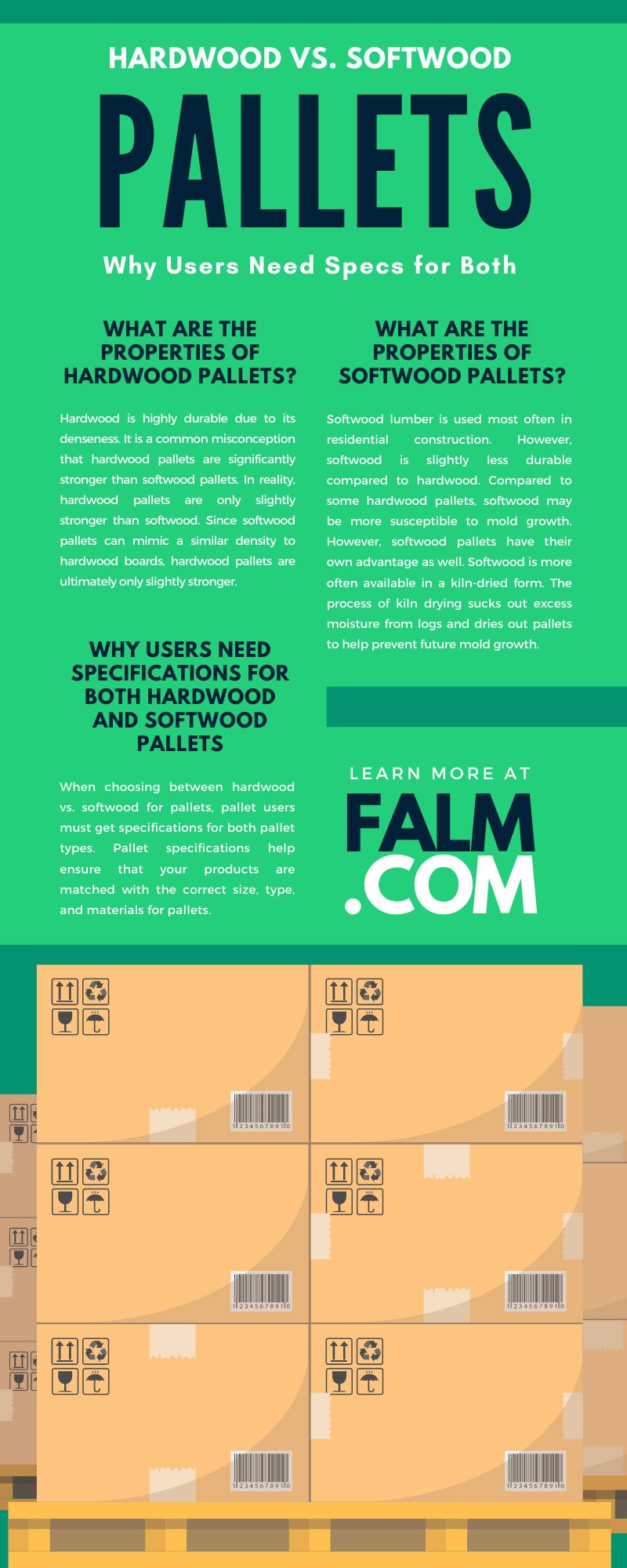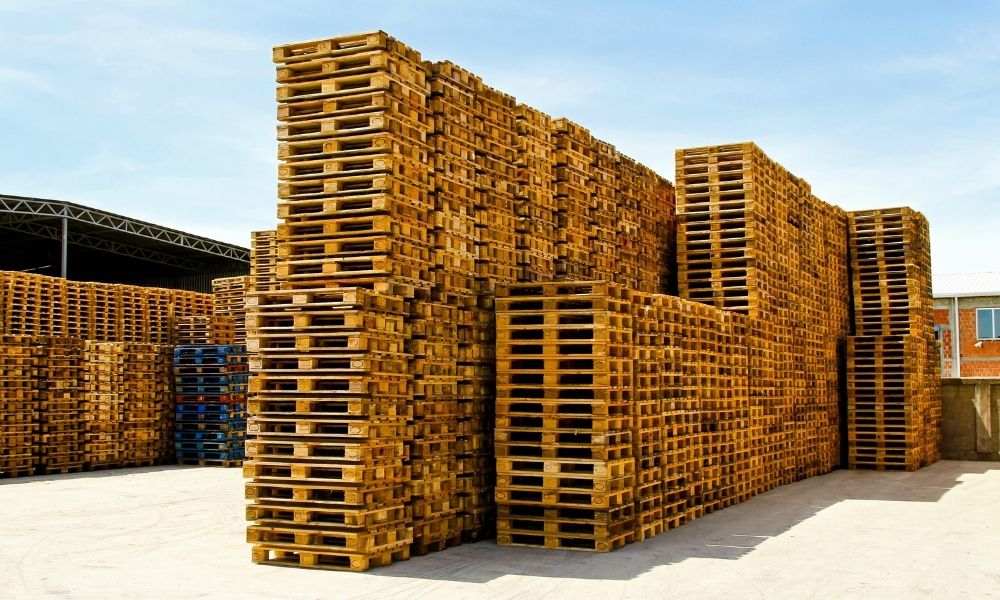- By First Alliance Logistics Management
- July 7, 2021
- Buying Pallets
When pallet providers manufacture pallets, they will often provide various hardwood and softwood materials to choose from. Although some may not understand how different species factor into pallet function and price, hardwood and softwood species can affect the use and specifications of pallets.
To learn more about the properties and differences of hardwood vs. softwood pallets and why users need specs for both, continue reading below.
What Are the Properties of Hardwood Pallets?
Hardwood comes from deciduous broadleaf trees such as oak trees, maple trees, beech trees, hickory trees, and walnut trees. These plants are dicot trees, which grow in different areas of the Midwest and east coast regions. In fact, more than half of the hardwood harvested domestically each year grows in regions spreading from the Midwest to the east coast. Other species of hardwood, such as maple, are imported from international countries, including Canada.
Hardwood is highly durable due to its denseness. It is a common misconception that hardwood pallets are significantly stronger than softwood pallets and can reduce damage to pallets. In reality, hardwood pallets are only slightly stronger than softwood. Softwood boards are able to mimic higher density hardwood with thicker dimensions. Since softwood pallets can mimic a similar density to hardwood boards, hardwood pallets are ultimately only slightly stronger.
Price is another factor that can fluctuate between hardwood and softwood materials. Lumber price trends show that the price of both hardwood and softwood pallets has significantly increased within the past annual quarter. During normal market conditions, hardwood is generally more expensive because of its density and durability. Hardwood lumber is also favored by other industrial users, such as railroad ties and crane mats. The demand in these other industries can have an effect on the price of hardwood pallets, as they are competing for the same raw materials.
The density of hardwood boards will better withstand external stressors than less dense softwood. Maple, oak, and other popular hardwood species also take longer to grow for harvesting than softwood lumber species.
Primary Properties of Hardwood Pallets
- Found in dicot trees
- Harvested mostly in the Midwest and east coast
- Thick, dense boards
- Highly durable
- Typically valued at higher prices
What Are the Properties of Softwood Pallets?
Softwood comes from coniferous and needle-bearing tree species. In the United States, Oregon and Georgia are two of the largest harvesters of softwood lumber.
Softwood lumber is used most often in residential construction. However, softwood is slightly less durable compared to hardwood.
Compared to some hardwood pallets, softwood may be more susceptible to mold growth. However, softwood pallets have their own advantage as well. Softwood is more often available in a kiln-dried form. The process of kiln drying sucks out excess moisture from logs and dries out pallets to help prevent future mold growth.
Softwood pallets also have different factors that affect their price. The cost of softwood pallets has consistently increased along with the average price of lumber this year. Softwood species, such as Douglas fir, have had one of the largest price increases. Softwood species also tend to be less expensive compared to most hardwood species.
During normal market conditions, the lower price of softwood compared to hardwood materials can be attributed to softwood’s weaker durability and growth rate. Since softwood is slightly weaker compared to hardwood, this material tends to be less durable. However, since most softwood species, such as pine and Douglas fir trees, grow faster than hardwood species, loggers can harvest these materials at a more rapid pace. More softwood resources are often available compared to hardwood lumber.
Primary Properties of Softwood Pallets
- Found in coniferous trees
- Harvested throughout the US
- Commonly used for construction
- Less strong
- Often kiln-dried
- Typically valued at lower prices compared to hardwood lumber
Why Users Need Specifications for Both Hardwood and Softwood Pallets
When choosing between hardwood vs. softwood for pallets, pallet users must get specifications for both pallet types.
However, fluctuating demand for hardwood and softwood boards can impact a user’s choice between using these two types of pallets. For example, if the demand for hardwood is high and softwood boards are more readily available, users will choose whatever wood type is accessible and most cost effective. Regardless of hardwood and softwood’s availabilities, specifications will still be necessary for both.
Pallet specifications help ensure that your products are matched with the correct size, type, and materials for pallets.
Specifications can be created using pallet design software. Pallet design software (PDS) develops the best pallet solution for shipping products through specific distribution channels. PDS systems use some of the latest engineering technologies available for designing loads for wooden pallets.
According to the National Wooden Pallet and Container Association, PDS can lead users through the complete specifications of pallet sizes, types, and styles. Pallet materials, dimensions, and arrangements, as well as the types and sizes of nails and staples used, can all be specified with this software.
Specifications can even be made to include both softwood and hardwood boards in the same pallet. Using hardwood and softwood in the same pallet can be helpful for pallet users who need to lower costs but can’t make enough compromises to switch to softwood boards entirely.
PDS also allows users to pick from various hardwood and softwood species in North America, South America, and Europe.
After the exact specifications have all been recorded inside PDS systems, these systems then produce a pallet specification sheet. A pallet specification sheet is a 2D drawing that illustrates the top, bottom, side, and ends of previewed pallets.
These previews can be edited with revisions to add or change specifications as well. With this technology, manufacturers can craft the most customized pallets for business products.
After reading over some of the main differences and properties of hardwood vs. softwood pallets, and why users need specs for both, we hope you better understand these two pallet types. Although these two wood types have several similarities, specifications help ensure that pallets are adequately built with the best materials for your products.
At First Alliance Logistics Management, we use pallet design software to help take hardwood vs. softwood density into account. Our software processes user specifications and helps create models for pallets to contain user loads and shipments.
First Alliance Logistics Management offers a wide range of pallet resources to help meet your business needs. Whether you’re looking for more information on how pallets are used in the industry or are interested in learning more about our wood pallet pick-up services, we offer some of the best pallet resources available. To learn more, check out our website.


